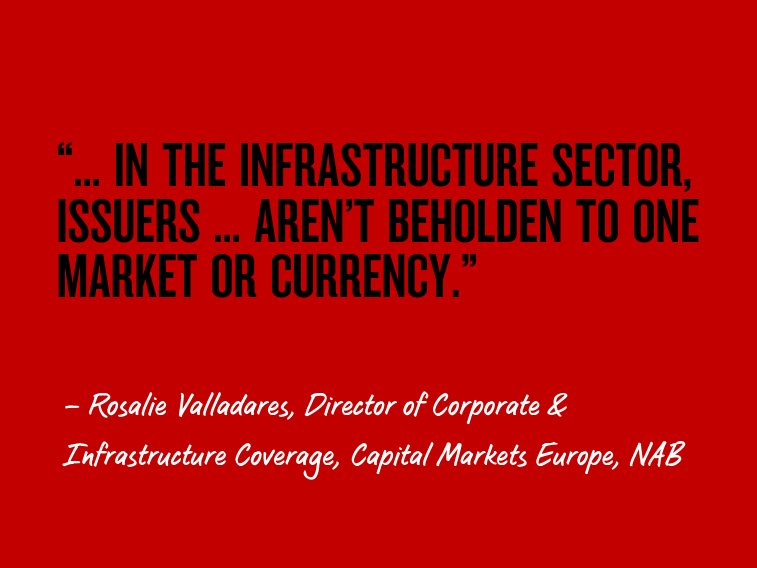Total spending grew 0.9% in June.


Investing in infrastructure is a long-term trend that will continue to endure global economic challenges, generating healthy returns and diversification opportunities as investors enhance focus on environmental, social and governance (ESG) factors.

Investing in infrastructure is a long-term trend that will endure in the face of the various challenges currently affecting the global economy, continuing to provide healthy returns and opportunities to diversify as investors enhance focus on environmental, social and governance (ESG) factors.
This was the message from a panel on infrastructure financing at the sixth annual Asia Pacific Debt Capital Markets conference organised by NAB in Singapore, Hong Kong and Tokyo.
Diversifying for scalability
Corporations around the world are keen to consider Asia in their search for fresh sources of capital.
Matt Cooper, Tax and Treasury Director at Places for People, a UK-based property development and management company, noted that the UK social housing sector would need net GBP40 billion in funding over the next decade1, and this would need to be complemented with a material increase in new debt which “will have to be diversified away from just sterling markets. I think we’re going to see a lot more overseas issuance, which is great. I’d love to see more overseas banks lending to the sector.”
“We did our first issue in Asia around a decade ago. And around 15 percent of our book was issued in Asian currencies and Australian dollars…we are now seeing more diversification overseas across the rest of the housing sector,” Cooper added.
On the other side of the world, Port of Melbourne, which was privatised three years ago, is moving fast to complete the shift to debt capital markets.
“We’ve made a lot of progress transitioning the portfolio from an acquisition finance facility to the long-term capital structure. About three quarters of the acquisition finance facility has now been termed out into capital markets via USPP and A$MTN markets. Our A$MTN transaction saw Asian participation and we fully intend to continue to tap Asian liquidity into the future,” said Andrew Vandeligt, Treasurer at Port of Melbourne.
ESG: An emerging priority
Panellists were also in agreement over the rising importance of building a business while being mindful of ESG and sustainability considerations.
Heathrow Airport, which is in the midst of a GBP14 billion expansion for a third runway, is a prime example of corporations pioneering sustainable growth models.
“Sustainability is at the core of our plans to expand Heathrow. In addition to protecting exotic animals and rivers during the works, we are prioritising carbon neutral growth. This includes making the airport operations carbon neutral by 2020, such as by switching to renewable energy for power and heating and transitioning the vehicle fleet to electric power, and using our passenger charges to incentivise airlines to use cleaner and quieter aircraft,” noted Sally Ding, Director of Treasury and Corporate Finance, at Heathrow Airport. “We’ve put a lot of focus on other social factors as well, such as communities, diversity, equality…it’s not a choice between [the airport] expansion and the environment. We need both to prosper.”
Cooper noted that Places for People spent GBP3.6 million on introducing energy-efficient measures at existing properties.
“The technology is still evolving and there’s a lot more that everyone needs to do to become more sustainable, more environmentally friendly. It’s becoming increasingly important to investors and it’s the right thing to do,” he said.
Vandeligt noted an upcoming annual report on sustainability and the positive results of a recent GRESB assessment as evidence of the growing focus on ESG factors at the Port of Melbourne. “We’re in the early stages of the ESG journey but the focus is evolving and increasing across the business and our stakeholders.”
Learning to stay the course
While the current global economic environment poses challenges, infrastructure investment is for the long haul, the panellists pointed out, urging issuers and investors to diversify in order to shield themselves from near-term regional shocks and be rewarded in the long run.
Rosalie Valladares, Director of Corporate and Infrastructure Coverage at Capital Markets Europe at NAB, noted that last year issuers in the UK had brought forward their 2019 refinancing efforts into the second half of 2018 and the first quarter of 2019 ahead of the initial Brexit deadline, and they were looking to diversify into new debt markets, such as Japan, Hong Kong and the Australian MTN (AMTN).
“Particularly in the infrastructure sector, issuers are tracking both public and private markets globally, and also bank markets… They aren’t beholden to one market or currency.” ” she said.
Heathrow, which has invested over GBP12 billion since 2008, will be wholly privately funded using a mix of equity and debt, Ding noted. “We are very diversified in terms of the currency market, investor base, duration, to make sure we maintain the right horizon, in terms of liquidity requirements.”
Addressing key global challenges Ding expressed confidence that a British exit from the European Union, even a hard one, would not materially impact Heathrow. Cooper agreed, noting that Brexit would have a limited impact on the UK social housing sector as demand far outstrips supply.
Vandeligt, meanwhile, said the Port of Melbourne did not expect a direct impact on the Port of Melbourne from the US-China trade conflict except in the event of a major escalation which could impact the Australian economy (and therefore potentially the port) more generally.
In conclusion, the panellists expressed confidence that, whatever issues the global economy confronts, infrastructure investments will remain attractive for investors with a long-term investment horizon. As Valladares put it: “Invest through the cycles, through the volatility.”
Speak to a banker© National Australia Bank Limited. ABN 12 004 044 937 AFSL and Australian Credit Licence 230686.